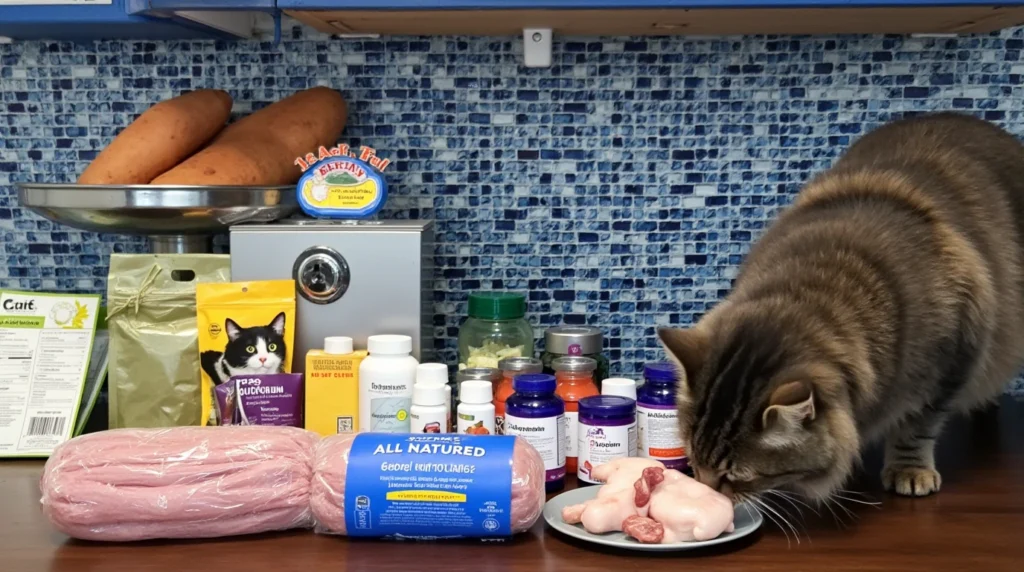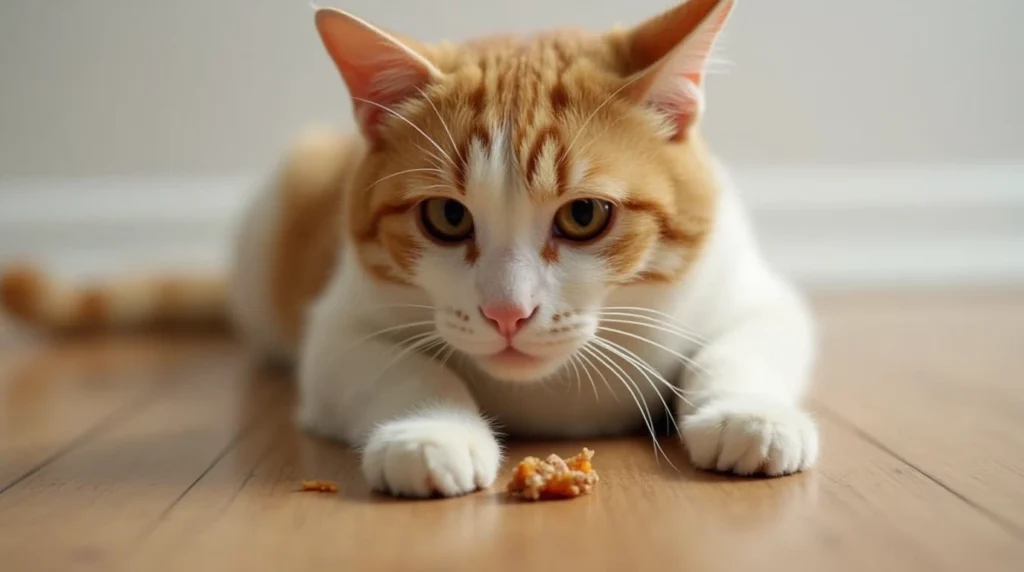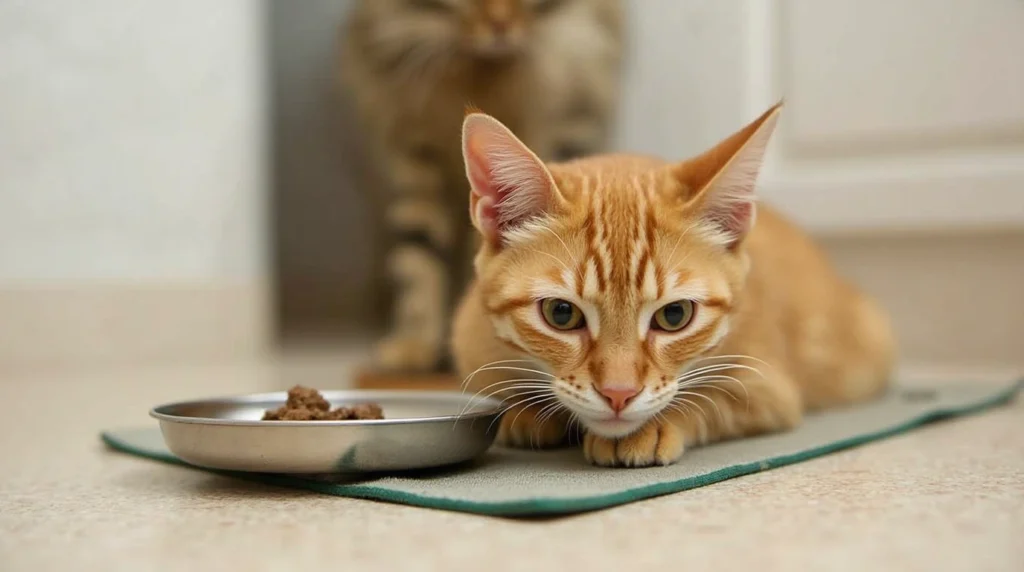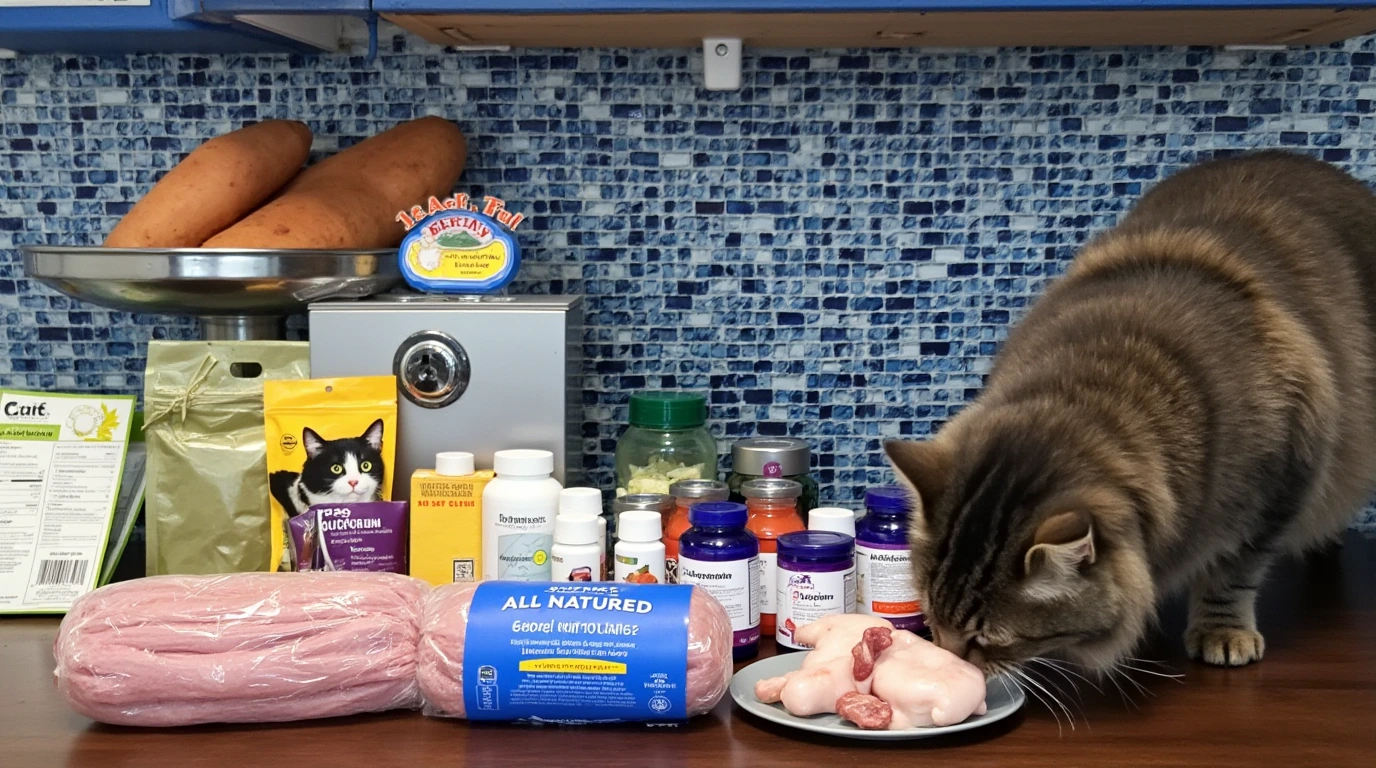Homemade cat food to gain weight – If you’re reading this with your cat curled up nearby—thinner than they used to be, maybe skipping meals, or just not looking like their usual fluffy self—first, take a breath. You’re not alone. Watching your cat lose weight, especially without knowing why, is scary. There’s a quiet kind of panic that creeps in: Are they sick? Are they just picky? Am I doing something wrong?
And while there are plenty of reasons a cat might drop weight—illness, stress, aging, or recovering from surgery—what matters most right now is helping them feel safe, nourished, and loved. One of the most powerful tools you have? What you feed them.
This guide is here to help. We’ve curated homemade cat food recipes specifically designed to support healthy weight gain. These are high-calorie, protein-rich meals that stay gentle on your cat’s digestion while still tasting delicious (even to the finicky ones). But more than that, we’ll walk you through why these ingredients work, how to serve them safely, and what signs to watch for as your cat regains strength.
TL;DR? This isn’t just a list of recipes. It’s a resource for cat parents who care deeply, want to act fast, and aren’t afraid to roll up their sleeves in the kitchen if it means helping their feline gain weight safely and steadily.
Let’s get into it — because your cat deserves to feel full, strong, and loved again.
Table of Contents

Ingredients That Help Cats Gain Weight Naturally
If your cat’s appetite has dipped or their ribs have started to show a little more than usual, the first instinct might be to just feed them more of what they’re already eating. But here’s the thing: gaining healthy weight isn’t about quantity alone—it’s about the right kind of calories.
High-Calorie, Cat-Safe Superfoods – homemade cat food to gain weight
Let’s start with the heroes of feline weight gain. These ingredients not only pack serious caloric density, but they also support muscle repair, coat health, and overall energy:
- Chicken Thighs (Skin-On): Dark meat has more fat than breast meat, which means more calories per bite. The skin adds healthy animal fats—something cats instinctively crave.
- Chicken or Beef Liver: Loaded with essential nutrients like vitamin A, iron, and B vitamins. Just a little goes a long way, though—too much can be toxic.
- Canned Sardines (in water): Fatty fish like sardines are rich in omega-3s, which support skin, joints, and appetite. Plus, the strong smell is hard for most cats to resist.
- Egg Yolks: Packed with healthy fats and amino acids, yolks are a gentle, digestible way to up calorie intake without overloading the digestive system.
- Pumpkin or Sweet Potato (Cooked, Mashed): Not calorie bombs, but perfect for adding fiber and texture. Helps digestion, which indirectly supports healthy eating habits.
- Goat’s Milk or Plain Greek Yogurt: High in fat and probiotics—but only in small quantities, and only if your cat tolerates dairy.
Why These Work for Weight Gain – homemade cat food to gain weight
Cats aren’t like dogs—they’re obligate carnivores, meaning their bodies are designed to thrive on meat-based proteins and animal fats. When a cat is underweight, feeding them low-fat kibble or high-carb fillers can actually worsen their condition. That’s why every ingredient above is chosen for maximum nutritional density in the smallest, most digestible portions.
And yes, taste matters too. A sick or stressed cat won’t touch food that smells bland or feels “off” in texture. Richer meats, oily fish, and lightly warmed servings can stimulate their appetite in ways dry kibble just can’t.
What’s the most calorie-dense meat for cats? homemade cat food to gain weight
Answer: Chicken thighs with the skin on are one of the most calorie-dense and affordable meat choices for cats. They’re rich in fat and flavor, making them ideal for underweight cats who need more energy per bite. Organ meats like liver are also dense, but should be limited to small portions to avoid vitamin toxicity.
Weight Gain Recipe 1 – Chicken Liver Boost Bowl -homemade cat food to gain weight
There’s something deeply comforting about preparing food that feels intentional—especially when it’s for a cat who needs a little extra love on their plate. This Chicken Liver Boost Bowl is exactly that: a simple, calorie-dense meal that supports healthy weight gain while staying easy on the stomach.
📋 Recipe Card
- Prep Time: 10 minutes
- Cook Time: 15 minutes
- Total Time: 25 minutes
- Serving Size: ~2 meals for an average-sized adult cat
- Calories per Serving: ~180
- Tags: High-calorie, soft texture, recovery-safe
- Buttons: Print | Save | Share
- ⭐ Optional Rating: ★★★★☆
Ingredients
- 100g chicken liver (fresh or frozen, cleaned)
- 1 small chicken thigh (skin on, boneless)
- 1 tsp olive oil or fish oil (for extra fat)
- 1 tbsp plain pumpkin puree (optional, for digestion)
- 1 egg yolk (lightly cooked)
- 1/8 tsp taurine powder (vital supplement – do not skip)
- Water or unsalted chicken broth (as needed for blending)
Instructions
- Prepare the Meats: Lightly sear the chicken thigh in a pan with olive oil until cooked through. Boil or pan-cook the chicken liver until no pink remains.
- Blend: In a food processor or blender, combine cooked chicken thigh, liver, egg yolk, pumpkin, and taurine. Add broth or warm water until you reach a soft, pâté-like texture.
- Cool and Serve: Let it cool slightly before serving. Serve slightly warm to boost aroma and appeal.
🧠 Why this works: Liver is calorie-rich and packed with nutrients cats often crave when ill or weak. Combining it with thigh meat and healthy fats creates a complete mini-meal that supports recovery and weight gain.
Can I make this in bulk and freeze it?
Answer: Yes, absolutely. You can portion the blended mix into ice cube trays, freeze, and thaw as needed. Just be sure not to freeze more than 2 weeks’ worth at a time to maintain nutritional value and flavor integrity.
Weight Gain Recipe 2 – Salmon & Egg Recovery Mix – homemade cat food to gain weight
When your cat’s appetite disappears, sometimes the secret weapon is scent. Enter this salmon-forward, creamy-textured recovery meal — designed to tempt even the fussiest eaters. With omega-3s for coat and brain health, plus calorie-rich fats, this recipe checks all the boxes for underweight or recovering cats.
📋 Recipe Card
- Prep Time: 5 minutes
- Cook Time: 10 minutes
- Total Time: 15 minutes
- Serving Size: ~2 portions for adult cats
- Calories per Serving: ~200
- Tags: High-fat, strong aroma, omega-rich
- Buttons: Print | Save | Share
- ⭐ Optional Rating: ★★★★★
Ingredients
- 1 small can wild-caught salmon (in water, bones removed)
- 1 whole egg (soft scrambled, no seasoning)
- 1/2 tbsp goat’s milk or plain Greek yogurt (optional)
- 1/4 tsp salmon oil or olive oil
- 1/8 tsp taurine supplement
- 1 tbsp cooked mashed sweet potato (optional binder)
- Warm water or broth (to adjust texture)
Instructions
- Cook the Egg: Lightly scramble the egg in a non-stick pan, leaving it soft and moist.
- Combine: In a bowl, mix in the canned salmon (drained), egg, yogurt, sweet potato, and taurine. Add salmon oil last for a finishing aroma.
- Adjust Texture: Add warm water or broth until it forms a soft mash—easy for cats to lap or chew.
- Serve Fresh: Offer slightly warm to enhance aroma, or refrigerate and use within 2 days.
💡 Pro tip: This mix is especially helpful for cats recovering from illness or surgery. The combination of healthy fats, protein, and soft consistency makes it easier to digest and more likely to be eaten.
Is canned salmon safe for cats?
Answer: Yes, as long as it’s plain (in water, no added salt or seasonings) and boneless. Canned salmon provides essential fats and protein, but should be balanced with other ingredients and not used as a sole diet due to low taurine content.

Weight Gain Recipe 3 – Creamy Chicken & Rice Mash (For Sensitive Stomachs) – homemade cat food to gain weight
Some cats don’t just need more calories — they need calories that won’t come back up. This gentle, creamy mash is made with easily digestible ingredients that support weight gain without upsetting sensitive stomachs. It’s bland enough to be safe, but rich enough to be effective.
📋 Recipe Card
- Prep Time: 10 minutes
- Cook Time: 20 minutes
- Total Time: 30 minutes
- Serving Size: ~2–3 meals (depending on cat size)
- Calories per Serving: ~160–180
- Tags: Digestive-friendly, soft texture, low-allergen
- Buttons: Print | Save | Share
- ⭐ Optional Rating: ★★★★☆
Ingredients
- 1 boneless, skinless chicken thigh (or breast for lower fat)
- 2 tbsp cooked white rice (well-mashed)
- 1/2 tbsp plain canned pumpkin or mashed carrot (optional fiber)
- 1 tsp olive oil or butter (unsalted)
- 1 egg yolk (lightly poached or steamed)
- 1/8 tsp taurine powder
- Warm filtered water or broth (for blending)
Instructions
- Cook the Chicken: Boil or steam until fully cooked, then shred finely or chop.
- Prepare the Mash: In a bowl, combine chicken, mashed rice, egg yolk, pumpkin, and oil.
- Blend for Texture: Add warm water or broth to reach a creamy, porridge-like texture. This helps cats lap it up even if they’re feeling weak or nauseous.
- Cool Slightly & Serve: Always serve warm but not hot — temperature impacts scent, and scent drives appetite.
🩺 Digestive support tip: This recipe can also double as a base. You can slowly introduce richer ingredients (like liver or sardines) into it once your cat’s stomach adjusts.
Can this be fed to senior cats?
Answer: Absolutely. This recipe is particularly helpful for senior cats with sensitive digestion or reduced appetite. Just make sure to include a taurine supplement and monitor hydration, as older cats often need encouragement to drink.
Tips to Encourage Eating in Underweight Cats – homemade cat food to gain weight
Let’s be honest: getting a cat to eat when they’ve decided they just aren’t into it is one of the most frustrating experiences a pet parent can face. You can prepare the perfect, vet-approved, lovingly blended meal — and still get that slow blink of rejection. So, what then?
The truth is, underweight cats aren’t just battling hunger. They may be dealing with pain, nausea, stress, or even just a bad memory tied to a certain smell. That’s why encouraging eating often means understanding why they’re not eating — and gently working around it.
Subtle Ways to Spark Appetite
Here’s how to nudge your cat toward the bowl — with love and a little strategy:
- Warm the Food Slightly: Cats rely heavily on scent. Warming food (just to body temp) makes it more aromatic, and therefore more enticing.
- Serve in Shallow Dishes: Deep bowls can irritate whiskers and make eating uncomfortable, especially for older or arthritic cats.
- Rotate Textures: Some cats prefer pâté-style food; others want chunkier bites. Try blending, mashing, or even slightly crisping meats to find what they prefer.
- Create a Quiet Feeding Space: No noise, no traffic, no kids yelling nearby. Cats eat best when they feel safe.
- Hand-Feeding or Finger Starts: Especially with bonded cats, starting the meal with a bite from your hand can build trust and trigger appetite.
- Try an Appetite Stimulant: In consultation with your vet, natural options like FortiFlora or prescription stimulants like mirtazapine can help.
Emotional Patience Matters
It’s tempting to panic when your cat skips yet another meal. But cats are intuitive — they sense your stress. The more pressure you apply, the more likely they are to retreat. Instead, aim for calm consistency. Small, frequent offerings. Minimal fuss if they decline. You’re playing the long game — and every tiny nibble counts.
Should I leave food out all day? – homemade cat food to gain weight
Answer: For underweight cats, free-feeding (leaving food out) can be helpful — if the food is fresh and appealing. Just avoid letting it sit too long or spoil, especially with homemade wet meals. Instead, try small portions every 3–4 hours.
How to Safely Increase Your Cat’s Calorie Intake – homemade cat food to gain weight
It’s easy to think, “Just feed them more and they’ll gain weight.” But with cats—especially those recovering from illness, stress, or age-related decline—piling on calories too quickly can do more harm than good.
Gradual, intentional increases are the key to healthy weight gain. Think of it as rebuilding, not refueling. And yes, there is such a thing as overfeeding—even when your cat looks thin.
Smart Calorie-Boosting Strategies
To help your cat bulk up without overwhelming their system, follow these principles:
- Increase Meal Frequency, Not Size: Offer 4–5 small meals daily rather than 1–2 large ones. Cats naturally eat multiple small meals in the wild.
- Add Healthy Fats Carefully: Boosting calories through fat is effective—just stick to cat-safe oils like fish oil, olive oil, or egg yolk in measured amounts.
- Monitor Weight Weekly: Use a kitchen scale (gently place your cat in a box) to track small weight changes. Aim for no more than 1–2% body weight gain per week.
- Balance the Diet: High-protein, moderate-fat meals are best. Avoid high-carb fillers—they can actually suppress appetite or cause blood sugar crashes.
- Supplement When Needed: Taurine, B vitamins, and omega-3s support metabolic function and appetite. Ask your vet before adding anything new.
Signs You’re Going Too Fast
Overfeeding—especially too much fat too soon—can trigger vomiting, diarrhea, or food refusal. Watch for these red flags:
- Lethargy or reduced appetite after meals
- Loose stools or vomiting
- Bloated or distended belly
- Sudden disinterest in previously enjoyed food
If any of these appear, scale back. Let the digestive system recalibrate before continuing.
How many extra calories does my cat need to gain weight? – homemade cat food to gain weight
Answer: Most underweight cats need 20–25% more than their maintenance calories to gain safely. For a typical 8–10 lb adult cat, that’s around 220–280 calories per day, depending on activity and metabolism. Always consult your vet for a tailored plan.

Storage & Safety Guidelines – homemade cat food to gain weight
Making homemade cat food is an act of care—but it’s also a balancing act between freshness, nutrition, and safety. Unlike store-bought kibble, homemade meals lack preservatives. That’s a good thing for health—but it also means you need to think ahead, store smart, and handle ingredients with the same caution you’d use for raw meat for humans.
Because when it comes to underweight cats, even a minor stomach upset can undo all your progress.
How to Store Homemade Cat Food Safely – homemade cat food to gain weight
- Refrigeration: Store freshly prepared food in an airtight glass or BPA-free plastic container. Use within 48–72 hours max. Label with the date made—memory is unreliable when you’re sleep-deprived and worried about your cat.
- Freezing: Freeze portions in silicone molds or ice cube trays. Once solid, transfer to a freezer-safe bag or container. Label and date. Use within 2–3 weeks for best nutrient retention.
- Portion Control: Freeze or store in single-serving sizes so you’re not constantly thawing and refreezing (which degrades quality and safety).
- Thawing: Always thaw in the fridge overnight. Never use the microwave unless on low/defrost—and stir thoroughly to prevent hot spots.
Food Handling Safety – homemade cat food to gain weight
- Wash hands thoroughly before and after handling food.
- Clean utensils and prep surfaces with hot, soapy water.
- Avoid cross-contamination—don’t use the same cutting board for raw chicken and your own lunch veggies.
- Discard uneaten food after 30–60 minutes, especially if served warm.
⚠️ Reminder: Cats are more sensitive to bacteria like Salmonella or Listeria than we sometimes assume. What seems “fine” to us might be a problem for their smaller, more delicate systems.
Can I batch cook and freeze a week’s worth of meals? – homemade cat food to gain weight
Answer: Yes, absolutely. In fact, batch-cooking is one of the best ways to stay consistent with homemade feeding. Just be sure to freeze individual servings, label everything clearly, and rotate stock to use the oldest meals first.

